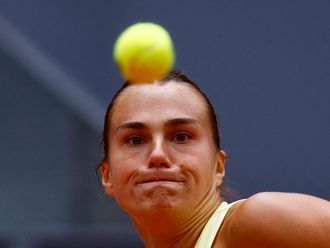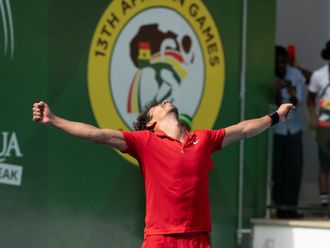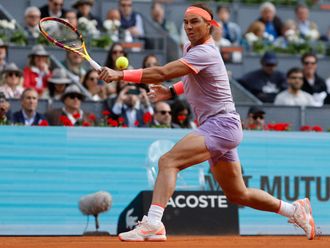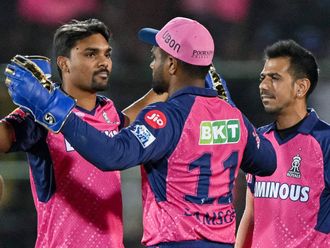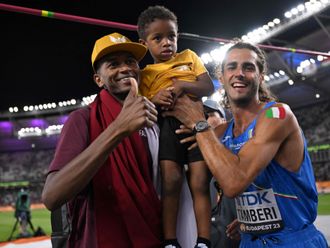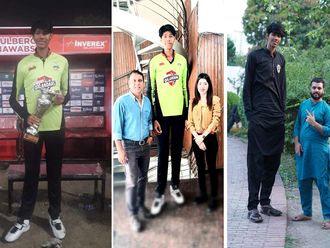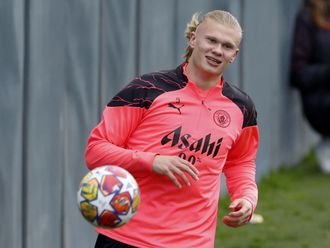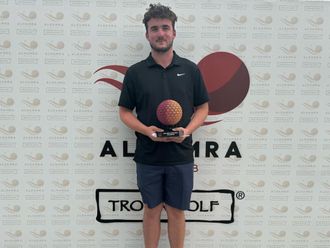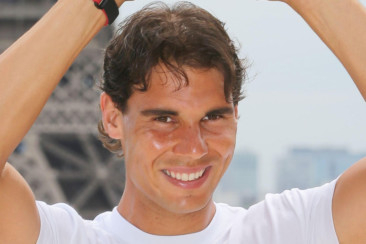
Abu Dhabi: Rafael Nadal winning the French Open: It’s one of sport’s biggest certainties, on a par with goals from Lionel Messi and Cristiano Ronaldo or English cricket’s internecine strife.
Since his maiden victory in 2005, the swashbuckling Spaniard has triumphed a remarkable nine times overall in Paris, which hosts the year’s second grand slam from a week on Sunday.
It’s the most singles titles anyone has claimed at one grand slam.
Slashing his racket like a machete through a jungle, Nadal’s been an irresistible force on clay, plundering 46 titles and posting the best statistical win-loss record in history on the surface of 333-28 before this week’s Italian Open in Rome.
However, the prospect of him adding a 10th French Open crown to his considerable trophy collection, which includes 14 grand slams, no longer appears inevitable.
That’s due to his recent travails both on clay and other surfaces and alarming admissions of anxiety after being debilitated by injury in recent years, chiefly to his knees.
Staggeringly, Nadal has slumped to seven in the world rankings after winning only one title in 2015 – on clay, naturally – the Argentina Open in March.
His lowest ranking since May 2005 is a result of a succession of wayward performances and tepid defeats – the world number 31 Fabio Fognini has beaten him twice on clay, for instance, at February’s Rio de Janeiro Open and last month’s Barcelona Open.
Otherwise, the world number one Novak Djokovic recorded his fifth victory in the pair’s last six meetings with a rudimentary 6-3, 6-3 win in the Monte Carlo Masters semi-finals last month.
Then on Sunday, Nadal’s recent woes on his favourite surface deepened when an inspired Andy Murray comfortably overcame the Spaniard 6-3, 6-2 for the first time on clay to win the Madrid Masters.
Earlier this week, a subdued Nadal, who only returned to action in January after wrist and back injuries and after having his appendix out during a two-month lay-off, admitted: “Obviously today I’m not as good as I [was]. Life has been fantastic with me. Today I’m not winning as much as I did in the past.”
Nadal is widely regarded as the fiercest and most mentally strong competitor the sport has ever seen.
With grim-faced determination, the indomitable Spaniard has overcome adversity countless times – winning an under-15 tournament with a broken finger, for instance.
Nadal’s psychological steel was forged by the fiery nature of his coach and uncle Toni, who has instilled him the ability to play every rally with the intensity of being match point up in a grand slam.
Yet in recent months, the King of Clay has been a pale shadow of his warrior self, plagued by rare and worrying bouts of self-doubt and low confidence.
In a candid interview earlier this year, he confessed with weary resignation: “I am feeling more tired than usual, feeling that I don’t have this self-confidence that when I hit the ball, I am going to hit the ball where I want to hit the ball, to go for the ball knowing that my position will be the right one.
“I need to fix again the nerves, the self-control on court.”
In his quest to recover his imperious best, the former world No.1 has switched to a new racket, which he says will provide him with more power.
Yet according to the American former tennis player and Sky Sports Television pundit Leif Shiras, the beleaguered 28-year-old’s problems are more mental than technical and that he is experiencing a syndrome endured by fighter pilots.
Shiras says the relentless grind of the tennis tour since Nadal turned professional in 2002 and his incessant battles with his body have taken a heavy cumulative toll on the Majorcan.
He said: “A confident young aviator will fearlessly push himself to the limit, doing whatever is required, however risky, to take down his foe. The constant stress, though, of putting your life on the line, pushing the envelope on each mission, is cumulative and gradually the pilot becomes more aware of all the things that can go wrong, and not just the day’s mission.
“The top gun who once flew by the seat of his pants is no longer the same.”
That may be true, but it is worth noting that only an astonishing onslaught of power-hitting from Robin Soderling in the 2009 quarter-finals interrupted Nadal’s Roland Garros hegemony with a four-set defeat.
It would be foolish, then, not to consider him the favourite along with the irrepressible Djokovic to reign supreme in early June, despite his psychological struggles and below-par displays in 2015.
He can also derive immense confidence from the fact that he has beaten the Serb all six times they have met at the tournament, including in the 2012 and 2014 finals.
A creature of habit, who relies on idiosyncrasies and rituals to focus while on the court such as carefully placed drinks bottles, expect Nadal to be revitalised when he is back in the comfort of familiar surroundings.
Then the time for gritted teeth will be over – but only until he is presented with the The Musketeers’ Cup on Sunday, June 7 and he can celebrate by gleefully chomping on his favourite possession in trademark fashion.


